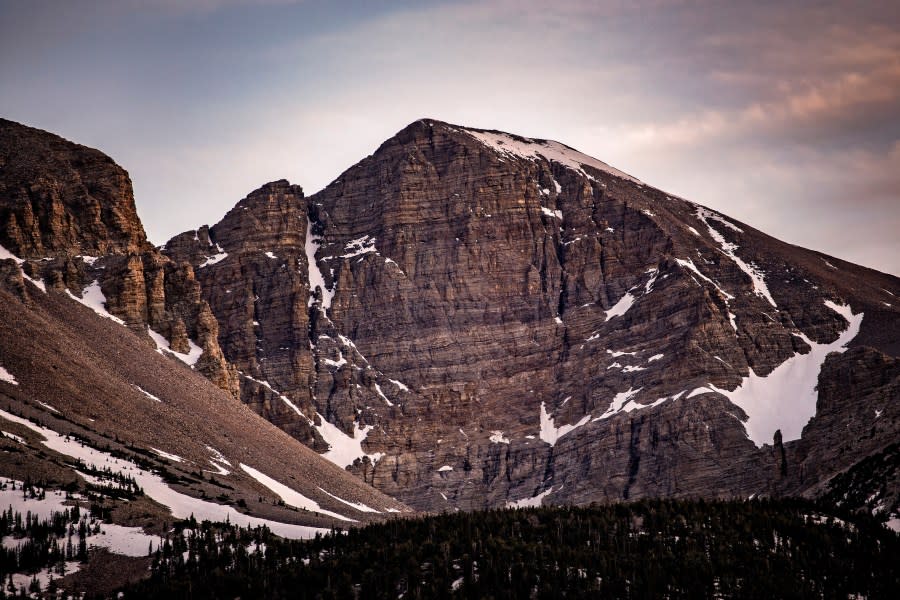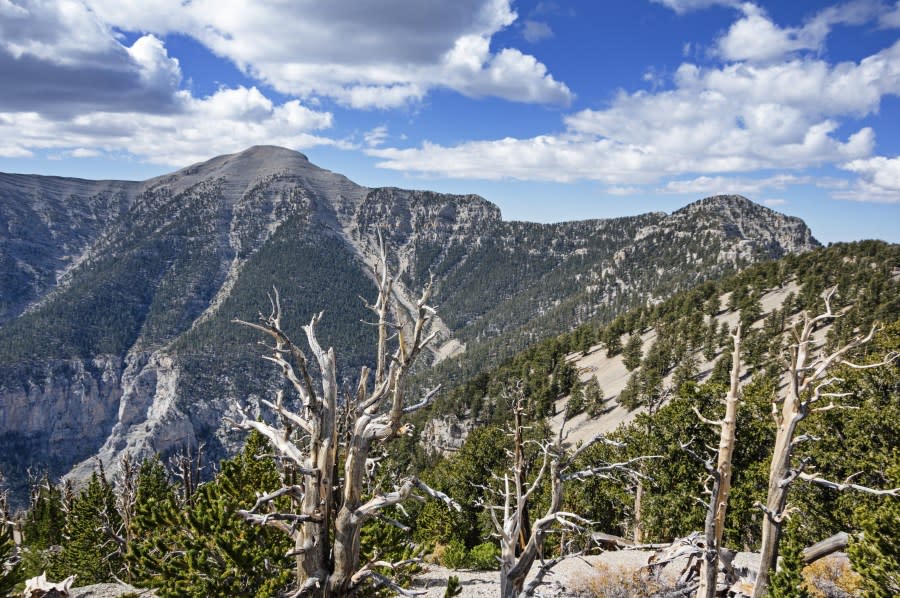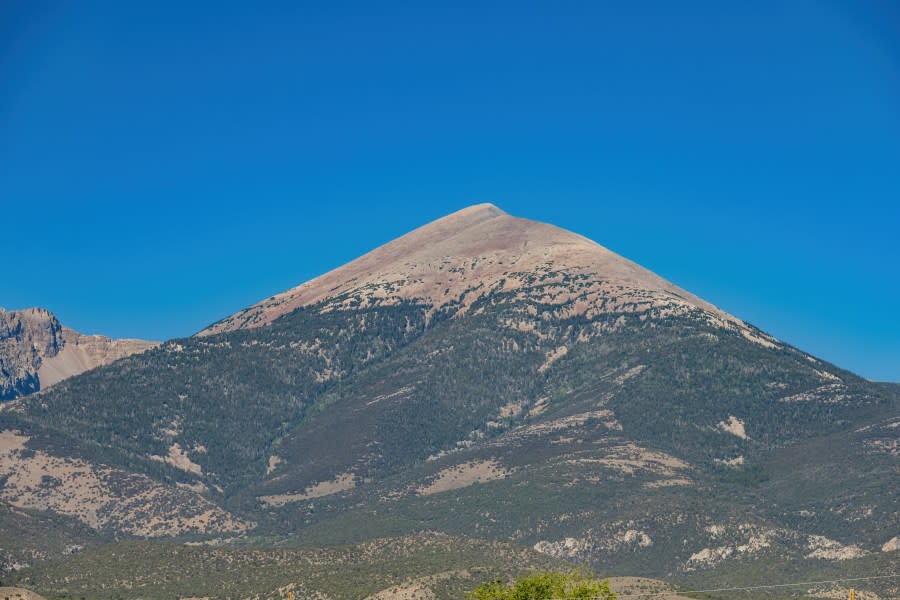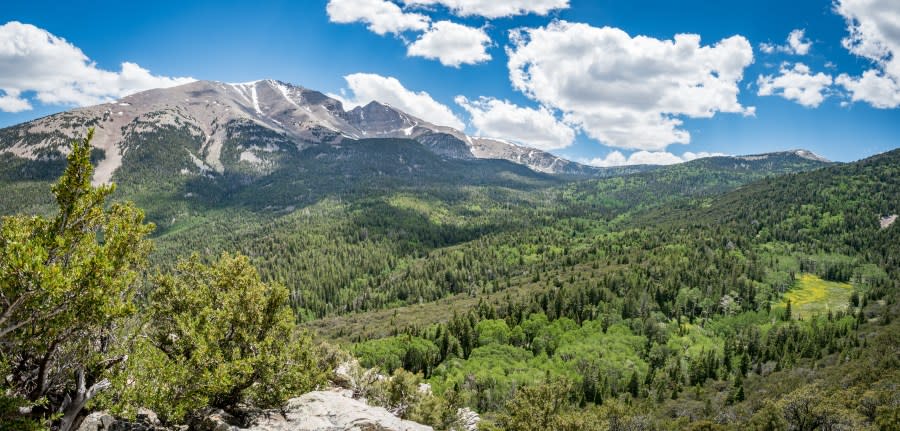10 highest peaks in Nevada just a sample of state’s majestic mountains

LAS VEGAS (KLAS) — The 10 highest peaks in Nevada offer challenges to hikers and rewards including wildlife, amazing views and a major break from the heat in the valleys below.
As summer arrives, it’s time to think about taking advantage of the Nevada’s status as the second-most mountainous state (behind only Alaska), boasting more than 300 named mountain ranges. There are taller mountains in other states, but there’s plenty to explore in the Silver State.
The list, as provided by Peakbagger.com, along with a short description of each:
Boundary Peak, 13,139 feet: Some dispute whether it’s even a separate peak because it’s so close to Montgomery Peak across the California border, but it holds the title as the highest point in Nevada. It’s rated as an advanced hike, 8-mile round trip starting at an elevation of 9,874 feet.
Wheeler Peak, 13,063 feet: A hike to Wheeler Peak is one of the highlights of a trip to Great Basin National Park. This hike is 8.6 miles round trip, beginning at Wheeler Peak Campground (10,160 feet).
Doso Doyabi, 12,771 feet: The second-highest peak in Great Basin National Park goes by the Shoshone name for White Mountain. Older references call it Jeff Davis Peak.
Baker Peak, 12,305 feet: Next at Great Basin, there’s Baker Peak, third highest in the park and fourth highest in the state. Be ready for a rugged 15-mile round-trip hike with an elevation gain of 4,000 feet.
Mount Moriah, 12,067 feet. An 8-mile out-and-back hike is considered moderately challenging, starting at 10,000 feet from Big Canyon — a long and rough road.
Mount Jefferson, 11,941 feet: The southern peak is the tallest mountain in Nye County. It’s about 50 miles northeast of Tonopah. From Pine Creek Campground, it’s an 11.8-mile round trip.
Pyramid Peak, 11,926 feet: Back to the Snake Range, which runs through Great Basin National Park, there’s Pyramid Peak. Various routes are available, including Baker Creek Trail, a 13.4 mile route with a 4,452-foot elevation gain.
Charleston Peak, 11,916 feet: Limited access due to trail closures. When the South Loop Trail is open (not now) it’s a 15.8-mile round trip with a 4,309-foot elevation gain.
North Schell Peak, 11,883 feet: In the Schell Range northeast of Ely, an 11.4-mile hike on the Timber Creek Trail will get you there with an elevation gain of 4,628 feet.
Mount Jefferson, North Summit, 11,814: A number of websites report that the trail from the south peak to the North Summit is overgrown and hard to follow.
Joel Brewster of the Las Vegas Mountaineers Club says he has done them all. And why stop there? The club has a regional reach with its own list of 50 peaks. Most are within a four-hour drive from Las Vegas. Brewster said 38 of the peaks on the list are in Nevada including Nevada’s top 10.
Put a list in front of a serious hiker, and watch them go. Brewster said 30 people have finished the list of 50 peaks, and he was the fifth to accomplish it.

For most casual hikers in the Las Vegas area, it’s starting to get too hot in the valley and Mt. Charleston is the next go-to destination. But damage from last summer’s bout with the remnants from Hurricane Hilary have changed the landscape, and the most-traveled routes to Charleston Peak aren’t available this year. There are still a couple of ways to get there, but it might be a good time to think about expanding your range.
That doesn’t mean you have to start at the top of the list.
The number of peaks at Great Basin National Park make it a great place to start.
“Great Basin is such a nice park,” Brewster said. It’s easy to get a campsite and avoid crowds, unlike other national parks that “tend to be overrun,” he said.

Seven of the state’s top peaks are there, so you’ll find a lot of great hiking, and you might even see Nevada’s only glacier at the base of Wheeler Peak at about 11,500 feet.
And Great Basin keeps on delivering after dark. “The stargazing is fantastic, and the mountains are amazing,” Brewster said.
There’s a little more traffic to Boundary Peak because of its status as the tallest. Hiking websites list all kinds of information about peaks, and serious mountaineers pay attention to rankings like prominence, and even the highest point in each mountain range and in each county. Checking those boxes is an added level of interest as you go down each list.
Brewster lists some other peaks to check out, some for their views and some for their challenges.
Nearby Hayford Peak (9,912 feet) in the Sheep Range has a nice view of Mt. Charleston, and Frenchman Mountain, the lowest peak on the list of 50 (4,052 feet), gives great views of Las Vegas and Lake Mead. “That’s a nice one even though it’s sort of a suburban peak,” Brewster said, adding that it’s a better destination in the winter.
He likes Moapa Peak (6,471 feet) — a steep hike with a 3,500-foot climb in a 6-mile round trip. Described as “a true desert classic” on summitpost.org, Moapa Peak requires a combination of hiking, mountaineering and scrambling. Brewster describes a “knife-edge summit ridge” that’s only 3 or 4 feet wide.
And Currant Mountain (11,513 feet) in central Nevada features some unique geology — lumpy rock that Brewster describes as “dumped cake batter.”

Before you get ahead of yourself, listen to experience. Brewster recommends working up to these peaks slowly. He says it’s OK to get a little out of your comfort zone, but just a little bit. Be prepared and get good gear — you’ll need it.
Always carry your own water and make sure people know where you are going and when you will return.
And mountain hiking brings some other safety concerns that you should think about. Dangerous wildlife encounters are rare, but mountain lions are out there and at least one person in the mountaineers club has seen one up close.

A more common concern is the weather. Brewster remembers being caught in a lightning storm on Mt. Charleston.
“It’s not fun. I’ve been up there,” he said. “I was going up North Loop. It started sprinkling but it didn’t look too ominous. All the sudden it started getting serious.”
Above the timberline, there’s no cover. And when it started coming in really hard, Brewster was as close as a half mile to lightning strikes.
Weather changes fast at high altitudes, and it’s best to avoid the highest trails if there’s even a chance of lightning.
Copyright 2024 Nexstar Media, Inc. All rights reserved. This material may not be published, broadcast, rewritten, or redistributed.
For the latest news, weather, sports, and streaming video, head to KLAS.

